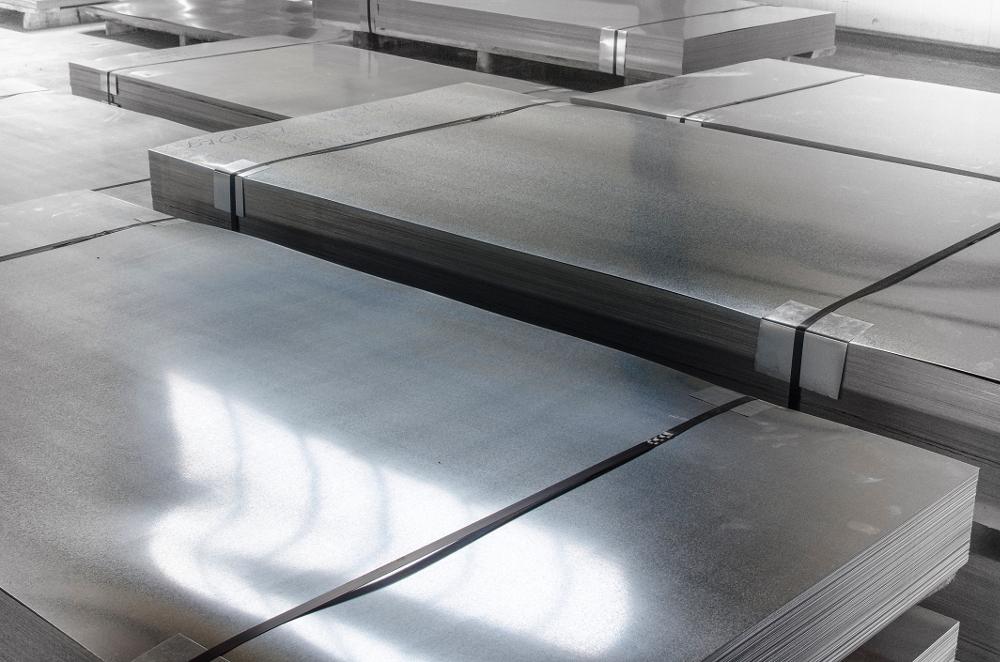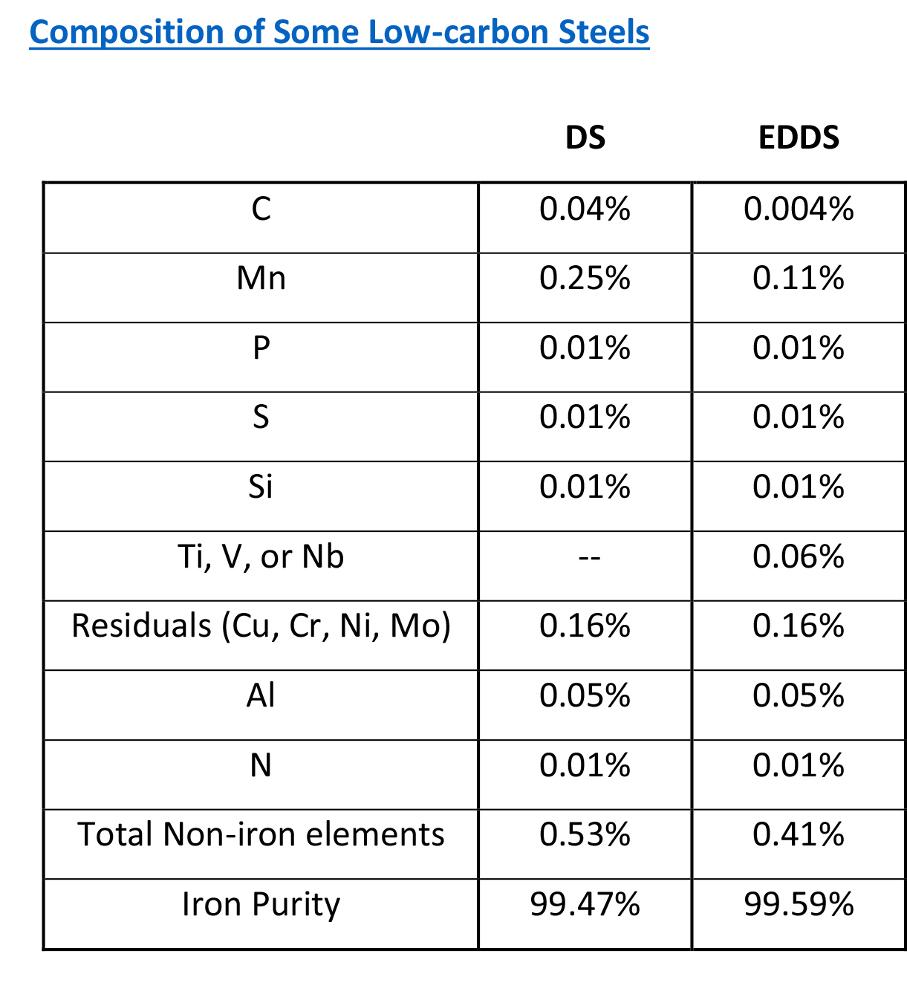President
- FMA
- The Fabricator
- FABTECH
- Canadian Metalworking
Categories
- Additive Manufacturing
- Aluminum Welding
- Arc Welding
- Assembly and Joining
- Automation and Robotics
- Bending and Forming
- Consumables
- Cutting and Weld Prep
- Electric Vehicles
- En Español
- Finishing
- Hydroforming
- Laser Cutting
- Laser Welding
- Machining
- Manufacturing Software
- Materials Handling
- Metals/Materials
- Oxyfuel Cutting
- Plasma Cutting
- Power Tools
- Punching and Other Holemaking
- Roll Forming
- Safety
- Sawing
- Shearing
- Shop Management
- Testing and Measuring
- Tube and Pipe Fabrication
- Tube and Pipe Production
- Waterjet Cutting
Industry Directory
Webcasts
Podcasts
FAB 40
Advertise
Subscribe
Account Login
Search
A closer look at low-carbon sheet steels
These materials may be referred to by different acronyms, but they are similar in low-carbon content
- By Daniel J. Schaeffler
- July 20, 2015
- Article
- Metals/Materials
Simply put, steel is just iron plus no more than about 2.1 percent carbon. (If the steel has more than 2.1 percent carbon, it’s called cast iron.) With low-carbon steels, the carbon level tops out at around 0.1 percent to 0.2 percent.
There is not much else in steel, but what is there is important for the properties you want. For example, a key property sought after in steel is strength. For most grades, as the strength increases, the formability or ductility decreases. We know that pure elements are very soft. This is why wedding bands are not made from pure 24-carat gold. Impurities are added to give the ring some strength and hardness, reducing the designation to 18-carat gold or less. (This is not to be confused with my wife’s cubic zirconium “diamond.”) Pure iron is similarly soft. The impurities added to iron to change the properties include not only carbon (C), but also manganese (Mn), silicon (Si), phosphorus (P), titanium (Ti), and other elements, depending on the alloy and steel mill processing.
If you were to put on your magnifying glasses, you would see that at an atomic level, pure iron (or any other element) looks like a 3-D network of racked billiard balls all the same size. To make a steel alloy, some of the iron billiard balls are replaced with ones made of Mn, Si, P, Ti, or some other elements, which are similar but not identical in size to the iron balls. The disruption in the pure iron atomic network caused by these alloying additions is responsible for what is known as solid solution hardening. As the alloying increases, the straining in the atomic 3-D structure increases, requiring more force to deform the sheet metal, making it a higher-strength steel. At low levels of alloying additions, the atomic network is still mainly iron, and therefore is relatively soft.
Even though all the balls touch, small gaps, interstices, exist between the balls. Only small atoms, like carbon, can fit in these gaps. These small atoms are called In ultra-low-carbon (ULC) steel, the carbon level is typically less than 50 parts per million, which is the same as less than 0.005 percent. As a result, most of the interstices are not occupied, making it an interstitial-free (IF) steel. Conventional steel mill processing can get the carbon level down to about 0.02 percent of the overall mix. To get to these ultra-low carbon levels, molten steel is processed under a vacuum, which bubbles out carbon, hydrogen, and nitrogen. This is the origin of the term vacuum degassed interstitial-free (VD-IF) steel. Because this steel alloy is mainly iron and all pure elements are very formable, it is also referred to as extra-deep-drawing steels (EDDS). So although you hear about ULC, IF, VD-IF, and EDDS, they all mean the same thing: the most formable and dent-prone grade of steel. While there are dozens of different grades of steel—and probably as many different ways to describe them—let’s highlight two of them: drawing steel (DS) and extra-deep-drawing steel (EDDS). A typical yield strength/elongation combination of 180 MPa/40 percent can be associated with DS, whereas EDDS can be 140 MPa / 44 percent. As you can see in Figure 1, the main chemistry difference is that DS has higher C and Mn, while EDDS also has a microalloying element to stabilize the carbon in the steel. In a ton of low-carbon DS produced by an integrated steel mill, 10.6 lbs. of impurities are found in the iron matrix, and a ton of EDDS has 8.3 lbs. of impurities. Either way, it’s mostly iron. Quite likely you’ve been exposed to a slew of different acronyms when dealing with steel. Again, some of them mean the same thing. It is also important to realize that most specifications have chemistry requirements, with only suggestions of typical values of strength and elongation. If you order steel based only on chemistry, the steel provider cannot guarantee that you will get consistent forming properties in different shipments. Steel mill processing can result in significant changes in strength and elongation in coils that have the same chemistry.
About the Author

Daniel J. Schaeffler
P.O. Box 187
Southfield, Michigan 48037
248-539-0162
Related Companies
subscribe now

The Fabricator is North America's leading magazine for the metal forming and fabricating industry. The magazine delivers the news, technical articles, and case histories that enable fabricators to do their jobs more efficiently. The Fabricator has served the industry since 1970.
start your free subscription- Stay connected from anywhere

Easily access valuable industry resources now with full access to the digital edition of The Fabricator.

Easily access valuable industry resources now with full access to the digital edition of The Welder.

Easily access valuable industry resources now with full access to the digital edition of The Tube and Pipe Journal.
- Podcasting
- Podcast:
- The Fabricator Podcast
- Published:
- 04/16/2024
- Running Time:
- 63:29
In this episode of The Fabricator Podcast, Caleb Chamberlain, co-founder and CEO of OSH Cut, discusses his company’s...
- Industry Events
16th Annual Safety Conference
- April 30 - May 1, 2024
- Elgin,
Pipe and Tube Conference
- May 21 - 22, 2024
- Omaha, NE
World-Class Roll Forming Workshop
- June 5 - 6, 2024
- Louisville, KY
Advanced Laser Application Workshop
- June 25 - 27, 2024
- Novi, MI

































